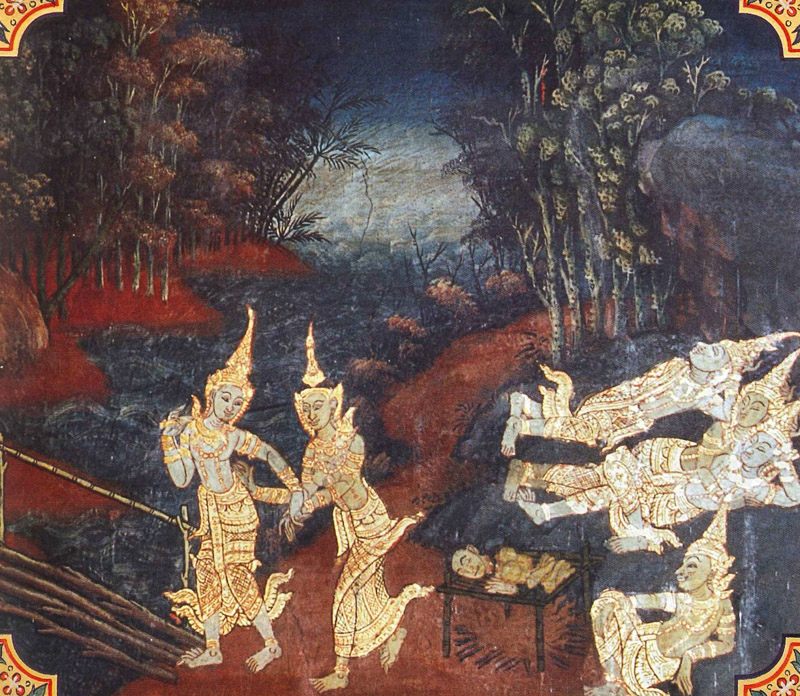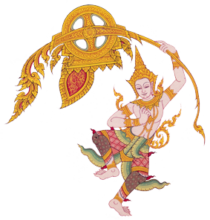
The Bodhisatta was once a crown prince. He and his six younger brothers faithfully served their father, the king. But the king was paranoid and suspected that one of his sons would kill him to take the throne, so he banished them all from the kingdom, not to return until after he died. The sons were sad, but agreed. They took their wives and set out with no destination in mind, eventually entering a forest where they could find no food or drink. When the suffering became too much, they killed the youngest brother’s wife, sliced her into thirteen parts (one for each person), and ate her. The Bodhisatta and his wife shared one part between them and saved the other. They did the same for another five days until the Bodhisatta’s wife was the only woman left alive. On the seventh day it was time to kill and eat her, but the Bodhisatta gave his brothers the portions of flesh they had saved, and they ate this instead.
That night the Bodhisatta and his wife fled. When she grew tired, he carried her on his shoulders, and when she grew thirsty, he cut his right knee with his sword and let her drink his blood. Eventually they reached the Ganges River, where they revived themselves with fruit and water and built a simple hut to live in.
While the Bodhisatta and his wife lived there, a convicted thief who’d been punished by having his hands, feet, nose, and ears cut off was sent drifting down the river in a small boat. As the thief floated by their home, the Bodhisatta heard his groans of pain and took pity on him. He brought him to their hut and treated his wounds, saving his life. While they all dwelled together in the hut, the wife fell in love with the thief and began an affair with him, having trysts while the Bodhisatta was collecting fruit. As her passion grew, the wife wanted the Bodhisatta dead and she pushed him off a cliff. But, unbeknownst to her, he fell into the top of a fig tree and survived.
The Bodhisatta couldn’t climb up or down, so he stayed put and survived on figs. An iguana who came daily to eat from the same tree eventually struck up a conversation with the Bodhisatta. After hearing his tale of woe, the iguana took him on his back and carried him down the cliff and out of the forest.
The Bodhisatta found a village and stayed there until he heard of his father’s death, then he returned to take the throne. As king, he ruled righteously and generously, putting money for his subjects in six alms halls every day.
The wife, meanwhile, had carried her lover out of the forest on her shoulders, and through pity they were able to get plenty of food as beggars. Later, people told her she should put her husband in a basket and go to the capital where the new king would surely show mercy and give them great riches. So they went, and lived comfortably from the alms halls.
One day the Bodhisatta, while riding his elephant through the streets giving alms to the poor, saw his wife, though she did not recognize him. He summoned her and told the assembled citizens who she was and what she had done to him. He declared that she deserved to die, but he would spare her life. Instead, he had the basket with her lover tied so tightly to her head that she could not remove it and banished them from his kingdom.
In the Lifetime of the Buddha
One of the Buddha’s disciples, while out on a morning alms round, saw a woman so beautiful he fell in love at first sight. The lovesick disciple became lean as a wild deer and could no longer concentrate on his studies or meditation. The Buddha told this story to remind him that women are vile and ungrateful and only bring misery.
The six brothers were earlier births of six of the Buddha’s elder disciples, and his wife was an earlier birth of Cinca-Manavika, a woman who had falsely claimed the Buddha impregnated her. The thief and iguana were earlier births of Devadatta, a disciple of the Buddha who became his nemesis, and Ananda, one of the Buddha’s top disciples.
